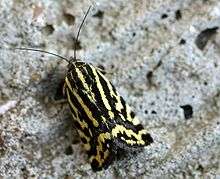Emmelia trabealis
| Emmelia trabealis | |
|---|---|
 | |
| Emmelia trabealis. Dorsal view | |
| | |
| Lateral view | |
| Scientific classification | |
| Kingdom: | Animalia |
| Phylum: | Arthropoda |
| Class: | Insecta |
| Order: | Lepidoptera |
| Family: | Noctuidae |
| Subfamily: | Acontiinae |
| Genus: | Emmelia |
| Species: | E. trabealis |
| Binomial name | |
| Emmelia trabealis (Scopoli, 1763) | |
| Synonyms | |
|
List
| |
The Emmelia trabealis, sometimes known as the Spotted Sulphur, is a species of moth of the family Noctuidae.[1][2]
Taxonomy
The species is sometimes placed in the genus Acontia and Emmelia is considered as a subgenus of Acontia.
Distribution
Spotted Sulphur can be found in most of Europe, in North Africa, the Middle East and Russia to northern China and Japan.[3][4] It was formerly resident in Great Britain, but has not been seen at any known breeding colonies since 25 June 1960 and is presumed extinct there.[5]
Habitat
This species prefers sandy soil, dry and warm areas, meadows and sunny slopes on which the bindweed occurs.
Description
The wingspan of Emmelia trabealis can reach 18–24 mm. The forewings show a very variable black drawings on a yellowish or dirty white background. The rear wings are reddish brown in color.[5]
Eggs are green, elongated and cone-shaped, with a flattened base and distinct longitudinal ribs. Caterpillars are reddish to greenish brown, with dark dorsal lines and a yellow side band, the head is relatively small and brown. Cocoons are red-brown or green.[5]
Biology
This species presents two overlapping generations a year, the second generation is generally missing in cool years. The moth flies from May to August depending on the location and then again from August to early September. The pupa overwinters. The larvae feed on field bindweed (Convolvulus arvensis) [5][6] and Polygonum species.[3]
Gallery
_trabealis_MHNT_dos.jpg) Museum specimen. ♂ - Dorsal side
Museum specimen. ♂ - Dorsal side_trabealis_MHNT_ventre.jpg) ♂ - Ventral side
♂ - Ventral side
Bibliography
- Arno Bergmann: Die Großschmetterlinge Mitteldeutschlands. Band 4/2, Eulen. Urania-Verlag, Jena 1954.
- Borkhausen, 1790, Naturgeschichte der Europäischen Schmetterlinge nach systematrischer Ordnung 3. Der Phalaenen erste Horden, die Spinner: pl. 10, fig. 8. TL: Europe.
- Denis & Schiffermüller, 1775, Ankündung eines systematischen Werkes von den Schmetterlingen der Wienergegend: 93. Unjustified emendation of Phalaena trabealis Scopoli, 1763.
- Fabricius, 1793, Entomologia Systematica, Emendata et Aucta 3 (1): 467. TL: Europe.
- Günter Ebert (Hrsg.): Die Schmetterlinge Baden-Württembergs. Band 5, Nachtfalter III (Sesiidae, Arctiidae, Noctuidae). Ulmer Verlag, Stuttgart 1997. ISBN 3-800-13481-0.
- Manfred Koch: Wir bestimmen Schmetterlinge: III Eulen Deutschlands. Neumann Verlag, Radebeul & Berlin 1958.
- Scopoli, 1763, Entomologica Carniolica Exhibens Insecta Carnioliae Indigena et Distributa in Ordines, Genera, Species, Varietas Methodo Linnaeana : 240
- Walker, 1865, List. Spec. Lep. Ins. Colln. Br. Mus. 33: 794. TL: Mauritius. HT: BMNH. male.
Walter Forster & Theodor A. Wohlfahrt: Die Schmetterlinge Mitteleuropas. Bd. IV, Eulen (Noctuidae). Franckh’sche Verlagsbuchhandlung, Stuttgart 1971, ISBN 3-440-03752-5.
References
External links
- Spotted Sulphur at UKmoths
- Lepiforum
- Schmetterling-raupe
- Paolo Mazzei, Daniel Morel, Raniero Panfili Moths and Butterflies of Europe and North Africa
| Wikimedia Commons has media related to Emmelia trabealis. |